Animals and fantastic places in Italy's museums: Campania
Second leg of the journey along Italy to discover animals, creatures, characters and fantastic places around the country: today we go to Campania. A project that Finestre Sull’Arte conducts in collaboration with the Ministry of Culture to find a new, interesting and fun key to visit museums, which are places that can be visited (and especially returned to) safely, as a family, with children. Also for this stage we have identified ten fantastic creatures, between Naples and Caserta, between Pompeii and Paestum: here they are!
1. The Nereid and the Pistrice of the National Archaeological Museum in Naples.
The pistrice, in Greek mythology, was a peculiar sea monster with the body of a horse, the head of a dragon and the tail of a sea serpent that is mostly found depicted in the processions of Neptune and sea gods. In this case we see him together with a Nereid, or sea nymph, who sits on the back of the creature, depicted in the act of lifting her front legs. Attempts have been made in the past to give a precise identity to the Nereid, but without arriving at satisfactory results. What is certain is that this very important statue is considered a unicum: scholar Armando Pistilli has in fact written that there are no known examples in ancient statuary that can be compared to this work, which was found in the ruins of the Villa of Lucullus at Posillipo and was purchased in the 19th century by King Ferdinand II of Bourbon for the collections of the Bourbon Museum. In 1840 the work thus entered the museum’s collection. This group so singular and of such high quality (it is supposed to derive from a Greek model) dates back to the first century B.C., but many parts were integrated in the nineteenth-century restoration, as they were missing: these are, in particular, the right leg and the front part of the left foot of the young woman, the front legs and the last coils of the tail of the pistrice, and the wave that is underneath them. The group is in marble but all additions were made in plaster.
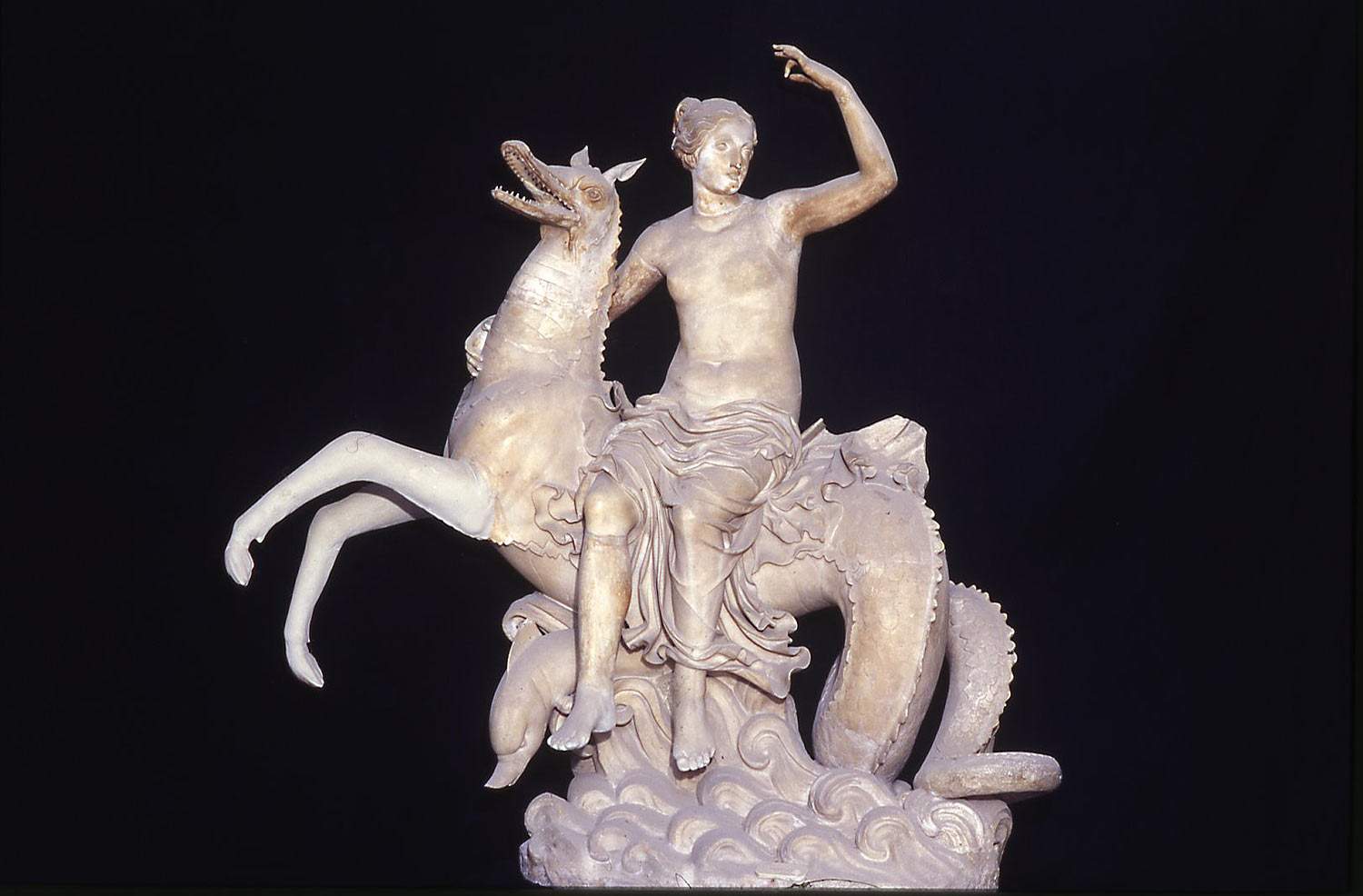
2. Trapezophore with Scylla and Centaur from the National Archaeological Museum, Naples.
Two mythological creatures occupy the sides of a trapezophore, or a shelf for supporting a table (from Greek trápeza, “table,” and feréin, “to carry”). This singular work, formerly in the collections of the Farnese family, was located in the seventeenth century at Villa Madama, after which, in the second half of the eighteenth century it was moved to the Farnesina and then moved to Naples in 1796. Scylla is the sea monster that, along with Charybdis, according to myth, guarded the Strait of Messina: against the two monsters Ulysses’ ship in theOdyssey collides. Here, it is depicted as a creature with the head of a woman and the tail of a fish, with the body where dog snouts open up and pounce on the castaways lost in the waves. On the opposite side here is the centaur, on whose back we see a winged genie, and not far away an eagle with a snake in its beak. It is hard to say what this scene might represent: the early 20th-century guide to the Naples Museum suggested that the two creatures were the guardians of Hades, so the trapezoid probably had a funerary use. Or it could have an allegorical character.
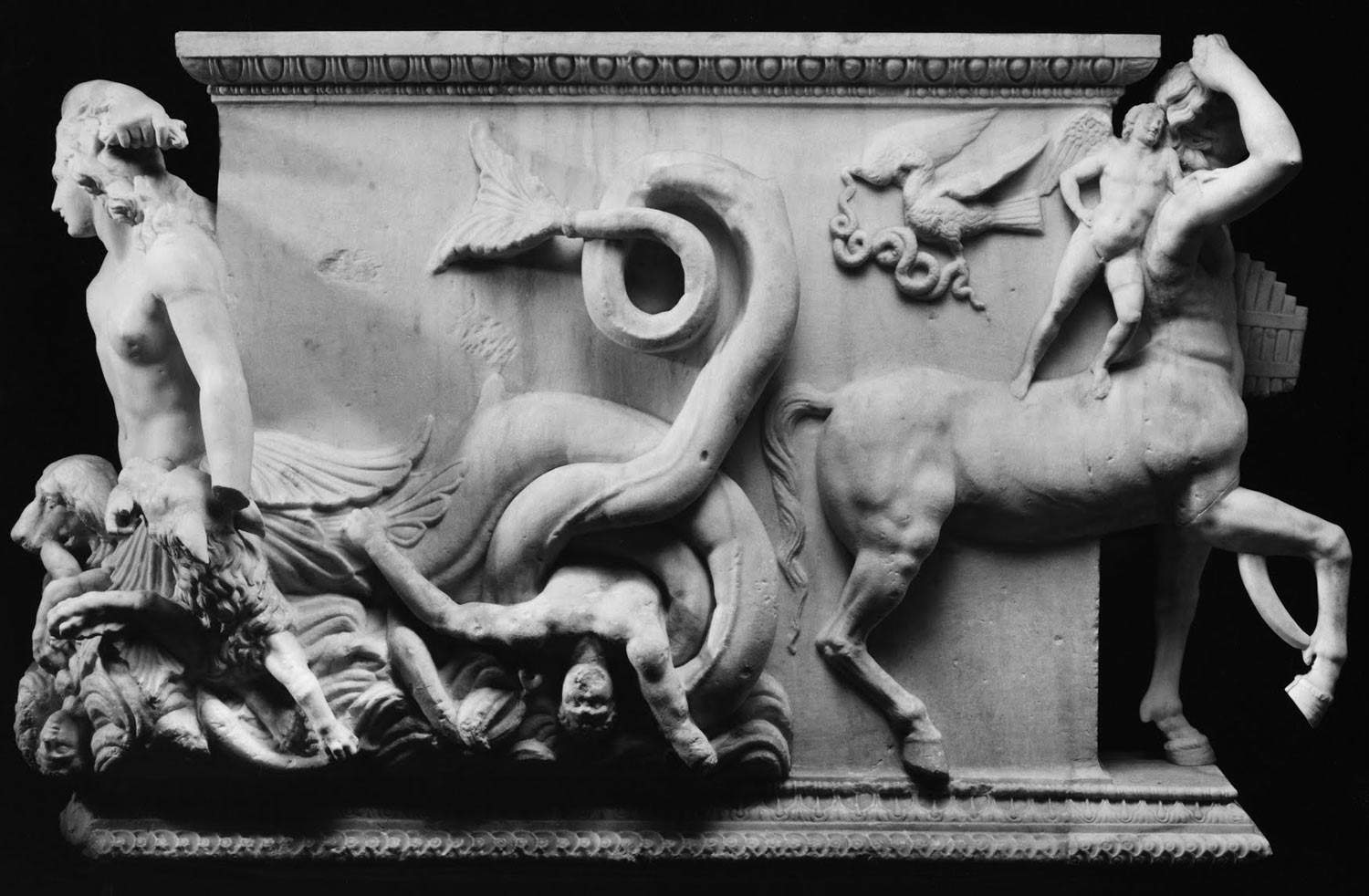
3. The Mermaid mosaic at the National Archaeological Museum in Naples.
More creatures from the world of mythology: here is a mermaid, which contrary to the one that has become established in the collective imagination, that is, the half-woman, half-fish creature that spread from the 8th-9th century, according to the ancient Greeks was a woman with the legs, wings and tail of a bird. In this case, we see the figure depicted on a first-century B.C. floor mosaic from a luxurious residence in Rome. It was not unusual to see emblémata, or figured pictures, in the center of mosaics: in this case, the mermaid, holding a vase with her left paw, is accompanied by a dove and the figure of a cupid, who follows her with a cup. This singular depiction could therefore allude to a religious ritual: the mermaid, in fact, carries a tray intended for offerings above her head.
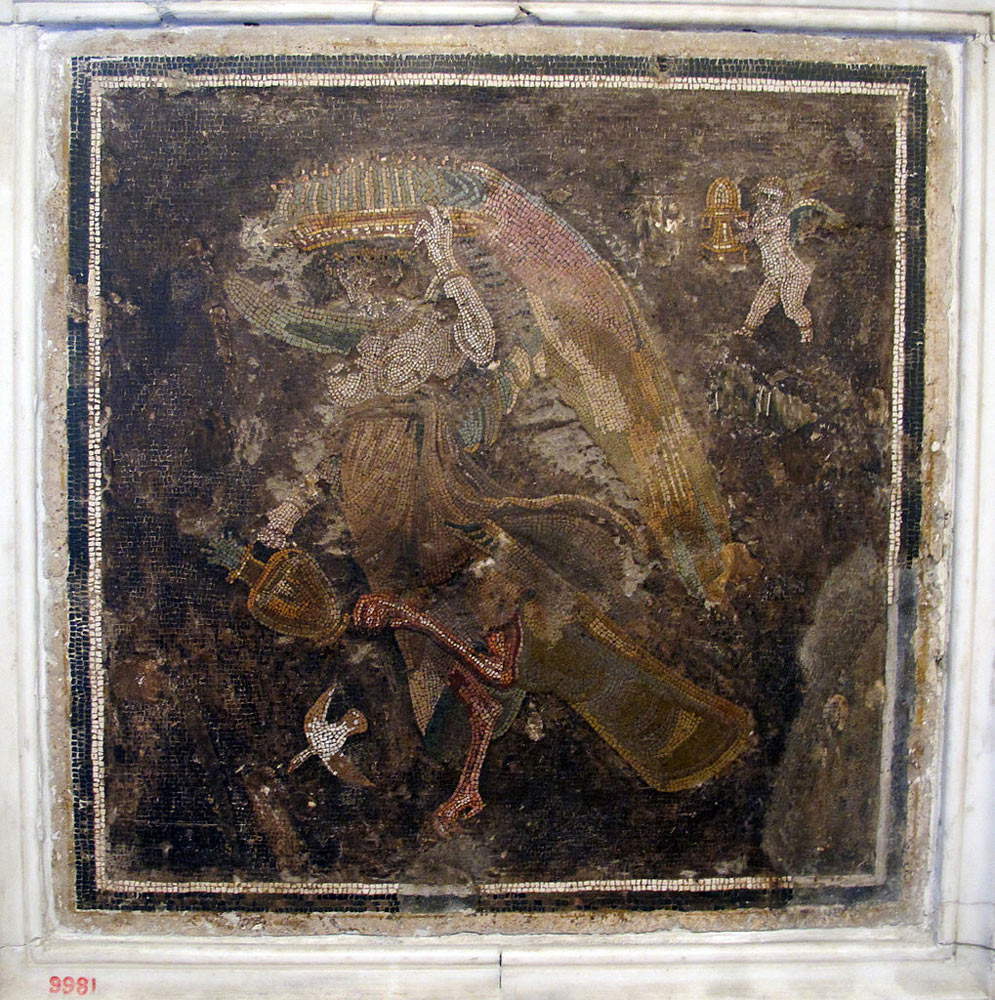
4. The hydra in Guglielmo della Porta’s Hercules child choking snakes at the National Museum of Capodimonte in Naples
This bronze by Guglielmo Della Porta (Porlezza, c. 1515 - Rome, 1577) is one of the best works by this talented artist, who often worked for the Farnese family, producing masterpieces that were inspired by classical statuary: theHercules child choking snakes is no exception, a work of such high quality that in the past it was even mistaken for an archaeological find. Here, Guglielmo Della Porta depicts one of the episodes of the Hercules myth: Hera, wife of Zeus, could not stand the baby Hercules, born of a betrayal by her husband (he was in fact the son of Zeus and Queen Alcmena), and to kill him she sent some snakes against him, which, however, the child hero managed to kill, suffocating them. The artist depicts the infant Hercules grappling with one of the snakes, caught in a strenuous struggle. Note how on the plinth instead appear reliefs depicting some of the labors that the hero would perform as an adult: in particular, Hercules is seen killing the Hydra of Lerna, a monstrous sea serpent with nine heads.
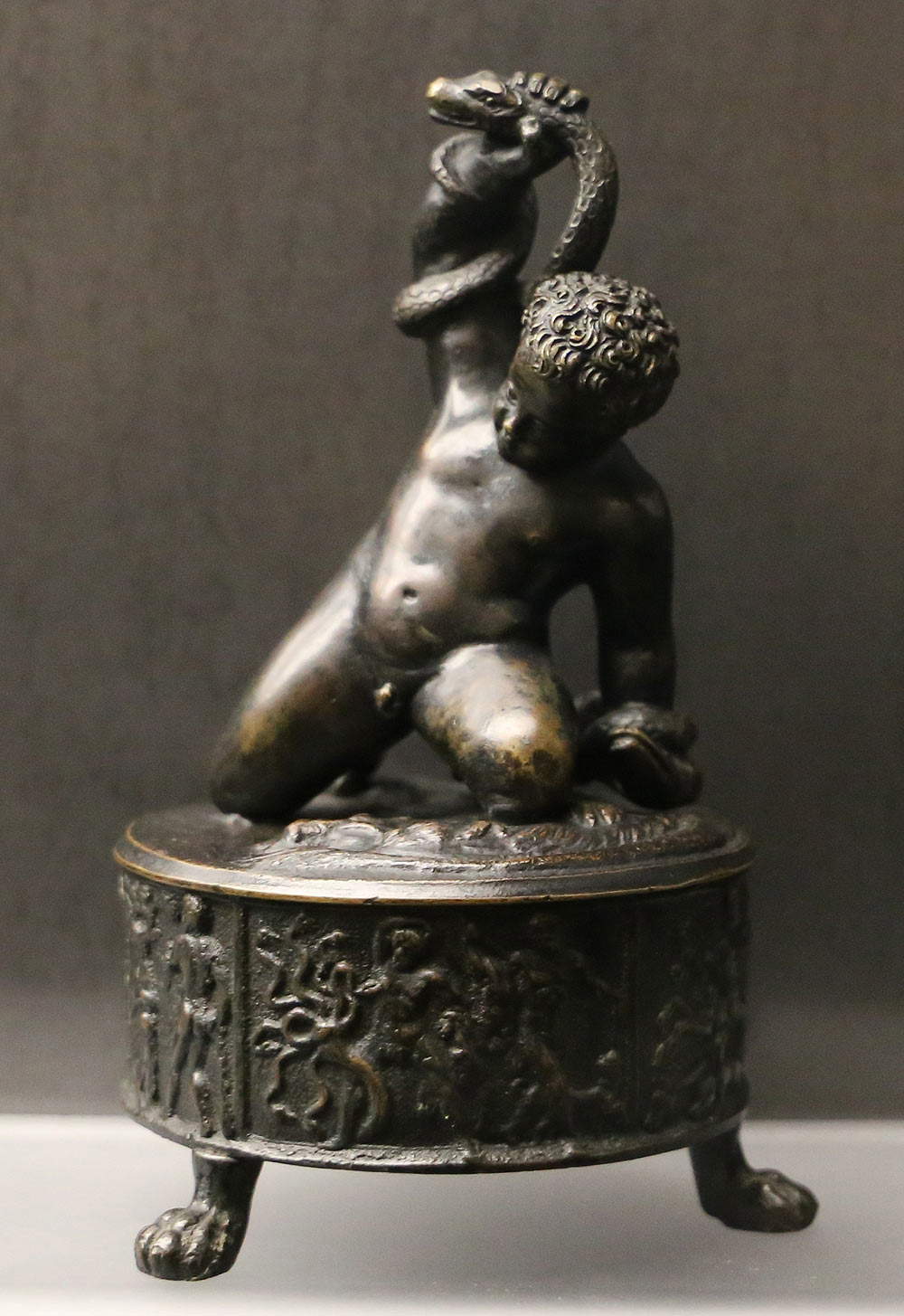
5. The centaur Chiron in the marble group of Achilles and Chiron by Filippo Tagliolini at the Capodimonte Museum in Naples
In 1739, in excavations at the Basilica of Herculaneum, a painting was discovered depicting the centaur Chiron intent on teaching little Achilles how to play the zither. Usually centaurs, half-horse, half-human creatures, are symbols of violence, instinct and brute force; Chiron, however, is an exception. The son of Chronos and Philia, Chiron is the good centaur, skilled in the arts, sciences, and medicine, and master of many Greek heroes, including Achilles himself, as he was considered the wisest of the centaurs. The small porcelain statue by Filippo Tagliolini (Fogliano di Cascia, 1745 - Naples, 1809), an expert artist at the Royal Factory in Naples (of which he was also chief modeler from 1780 onward), reproduced the Herculaneum fresco with the biscuit technique (by which a work with a white, opaque marble-like appearance is obtained), producing an object belonging to a genre particularly in vogue at the Neapolitan court in the late 18th and early 19th centuries (the work, in fact, is datable to 1796-1805).
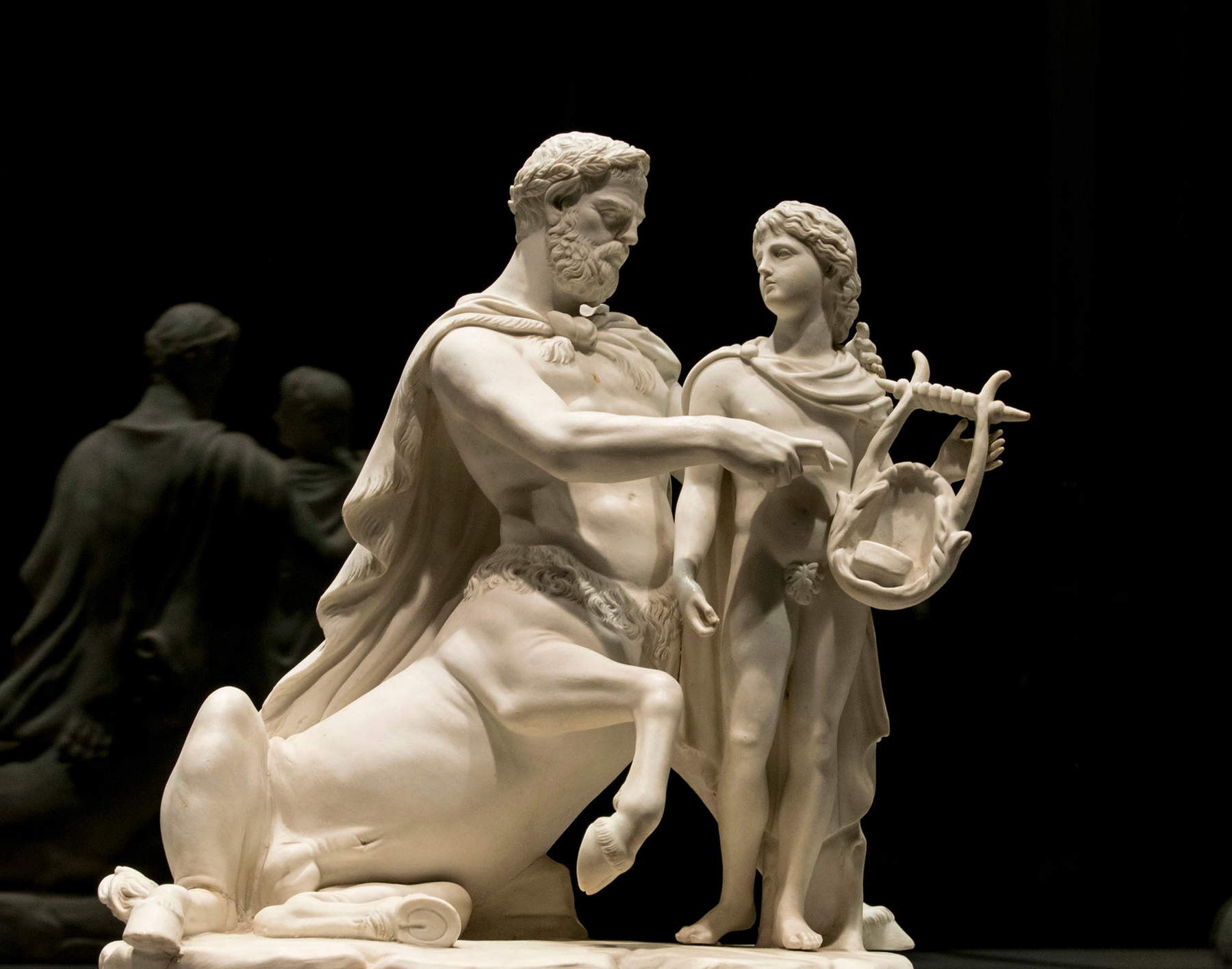
6. Actaeon in the fountain of Diana and Actaeon at the Royal Palace of Caserta.
Another story from Greek mythology, whose protagonist is the hapless hunter Actaeon, who during a hunting trip comes across the goddess Diana while bathing naked together with her handmaids. For daring to see the goddess of hunting, a virgin, with nothing on, Actaeon suffers a fierce punishment: he is turned into a stag and thus mauled by her dogs, who do not recognize him. There are many works in which Actaeon is depicted as a man in the guise of a deer: no exception is the Fountain of Diana and Actaeon, one of the most beautiful and admired sculptural groups in the Royal Palace of Caserta, and probably the most famous. The sculptures, which rest on mock rocks rising above the water, is the 1773 work of Paolo Persico (Sorrento, 1729 - Naples, 1796), who lavished here one of his most scenic works. For its realization in marble, the artist, to whom we owe the design of the fountain in addition to the main figures (those of Diana and Actaeon) was helped by Angelo Brunelli, who took care of the figures of the nymphs, and by Pietro Solari to whom the dogs belonged instead.
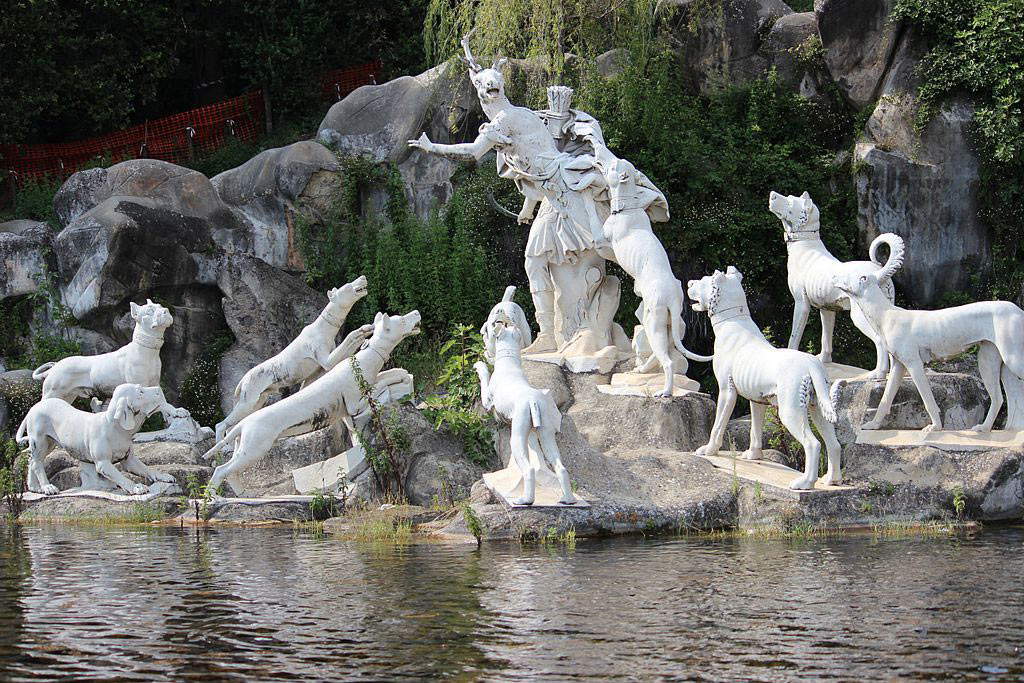
7. The Agathodaimon in the House of the Cryptoporticus in Pompeii.
TheAgathodaimon, or “Agatodemon” in Italian, was according to Greek mythology a good demon (this literally means his name in Greek), and was considered a genie who protected grain and crops. He could take many different guises: in many cases he was depicted as a serpent with a crowned head, sometimes bearing a lotus flower in his tail. In the case of the fresco decorating the Cryptoporticus House in Pompeii, the Agathodemon is simply a snake slithering through a meadow and addressing the god Mercury. The god holds the caduceus, the staff adorned with two snakes, a symbol of wisdom (even today the caduceus is a symbol of pharmacists as it is associated with healing, not to be confused with the staff of Asclepius, which is instead associated with medicine). Completing the symbolism is the peacock, a symbol of longevity and rebirth. The House of the Cryptoporticus in Pompeii takes its name from the covered corridor (“cryptoporticus,” in fact) that is itself adorned with fantastic creatures: satyrs, in this case.
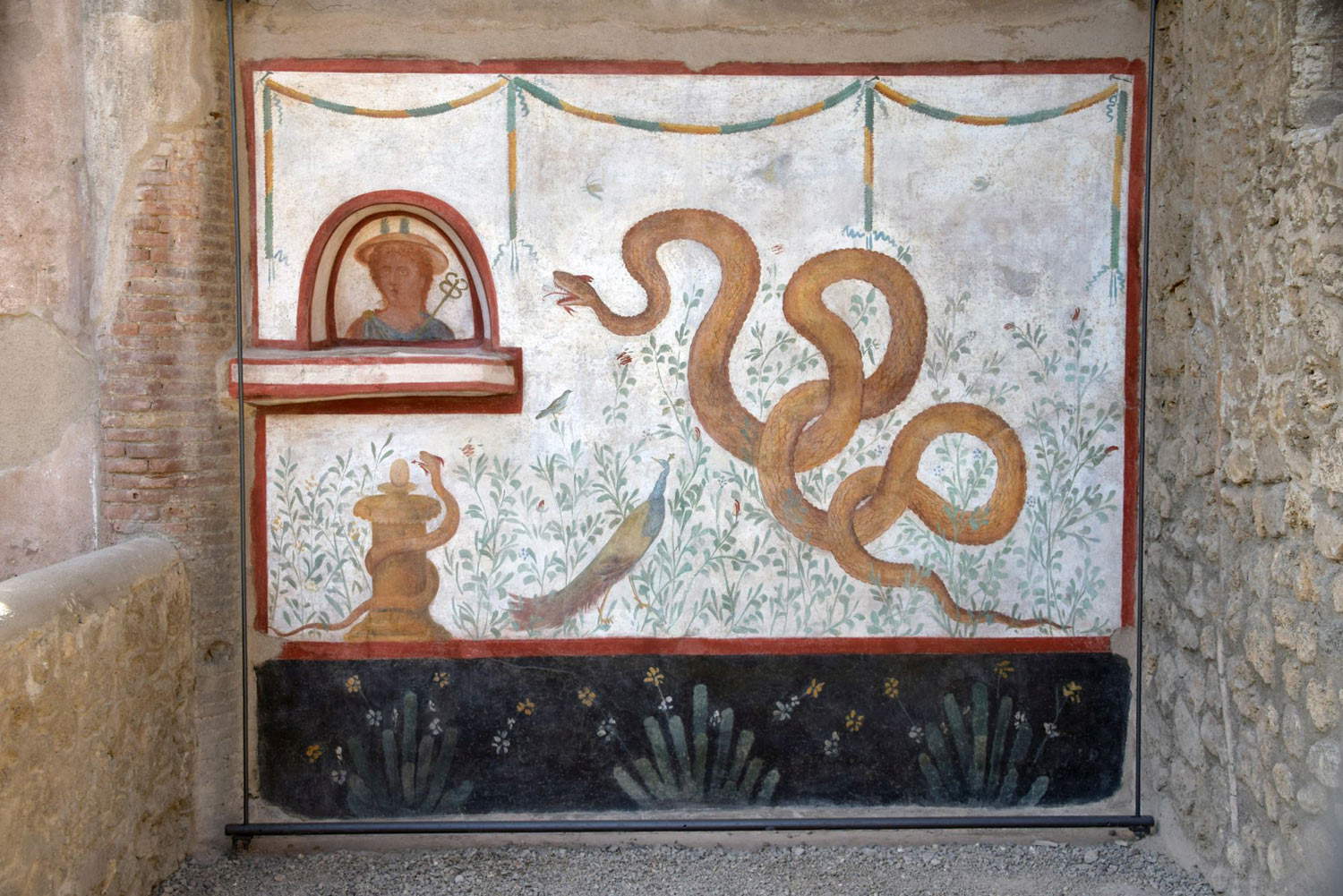
8. The sphinx of the National Archaeological Museum of Sannio Caudino in Montesarchio.
The beautiful marble sphinx of the National Archaeological Museum of Sannio Caudino in Montesarchio (Benevento), which unfortunately today totally lacks its front legs and part of its hind legs, as well as a portion of its face, was found in excavations conducted between 1975 and 1977 at Masseria Foglia in Montesarchio. A complex of Roman-era buildings discovered in 1924 was located here: excavations in the 1970s led scholars to note that it was a luxurious structure, also equipped with a bath complex. In one of the rooms of this sumptuous complex was found the very sphinx in question, which probably decorated a trapezophore, as the square marble block we see behind it would suggest. The sphinx of Montesarchio, as per typical iconography, is seated on its hind legs: it is a creature with the body of a lion and the head of a woman, born according to myth from the union between Orto and Echidna.
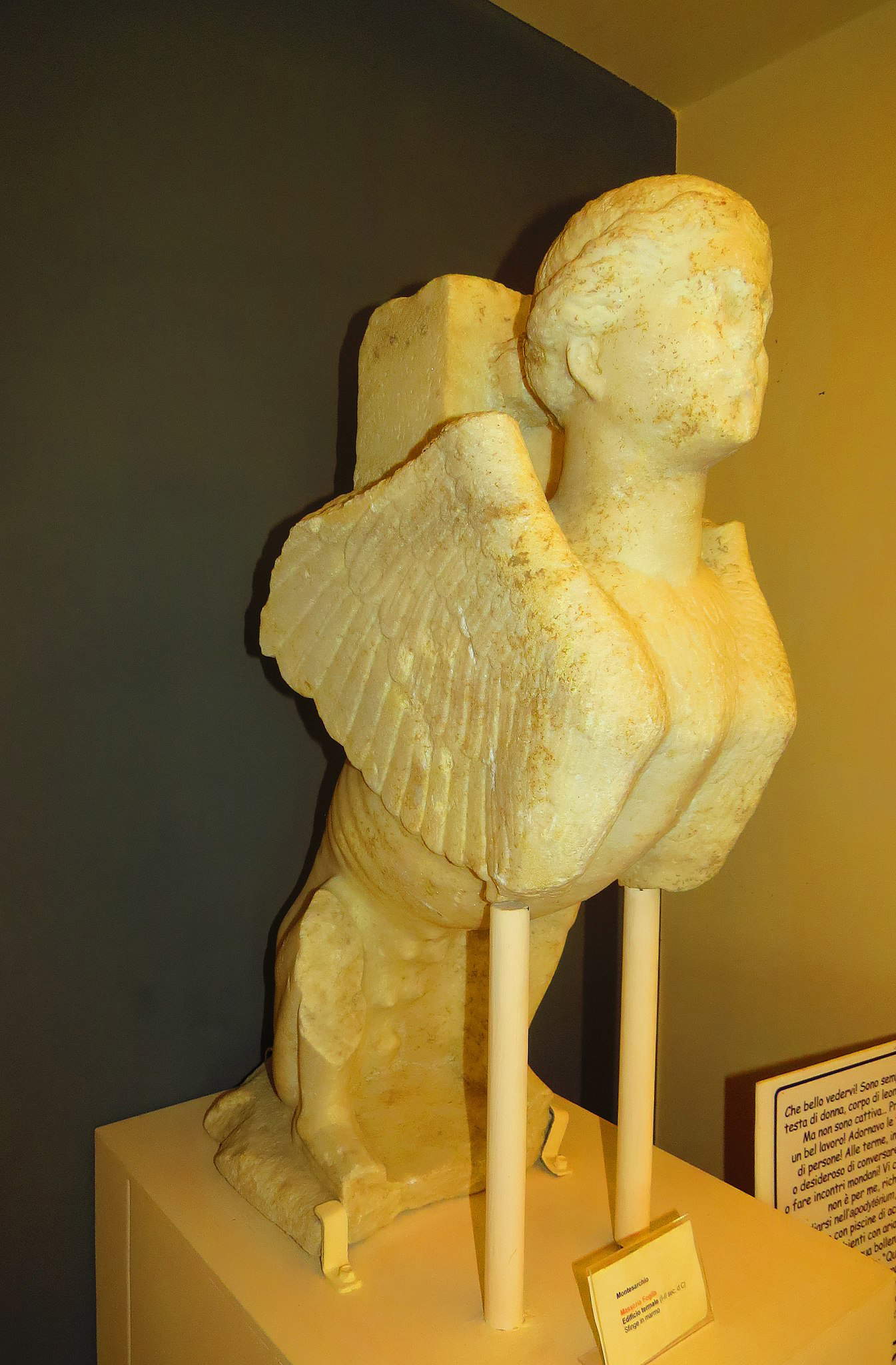
9. The sea monster in Elie Honoré Montagny’s Galatea at the Royal Palace, Naples.
According to myth, Galatea (from Greek gála, “milk,” or galéne, “calm”), was a Nereid, a sea nymph, in love with the young Acis, who was later killed by the Cyclops Polyphemus, who was in turn in love with Galatea and jealous of his rival. According to the myth, the Olympian gods, moved by pity for the young man, transformed him into a river, the Aci, which is located near Mount Etna in Sicily. In the history of art it is not uncommon to come across scenes celebrating Galatea’s triumph, accompanied by other nymphs, cupids, and tritons, and dragged across the sea by dolphins or, as in this case, by a huge sea monster, which is guided by Galatea with a bridle. The author of the painting, Elie Honoré Montagny, a pupil of Jacques-Louis David, settled in Naples between 1804 and 1815, and during his Neapolitan sojourn he painted his most important and famous works, including the Triumph of Galatea at the Royal Palace, signed and dated 1812, which is probably to be identified with the “oil-painted picture representing Galatea with various Cupids and Nymphs around her” that decorated the Cabinet of the Bath of the Palace of Portici in 1817. In this work, commissioned by Caroline Murat, “the recourse to the antique becomes more soft,” scholar Ornella Scognamiglio has written, “and blends into a whole with a Pompeian flavor (the sea breeze ruffling the hair and swelling the cloaks transforming them into sails, the dolphins lightning plying the wave, the biting tritons, the river cane and coral indicating the eternal union between Acis and Galatea) without becoming erudite annotation or antiquarian imprint.”
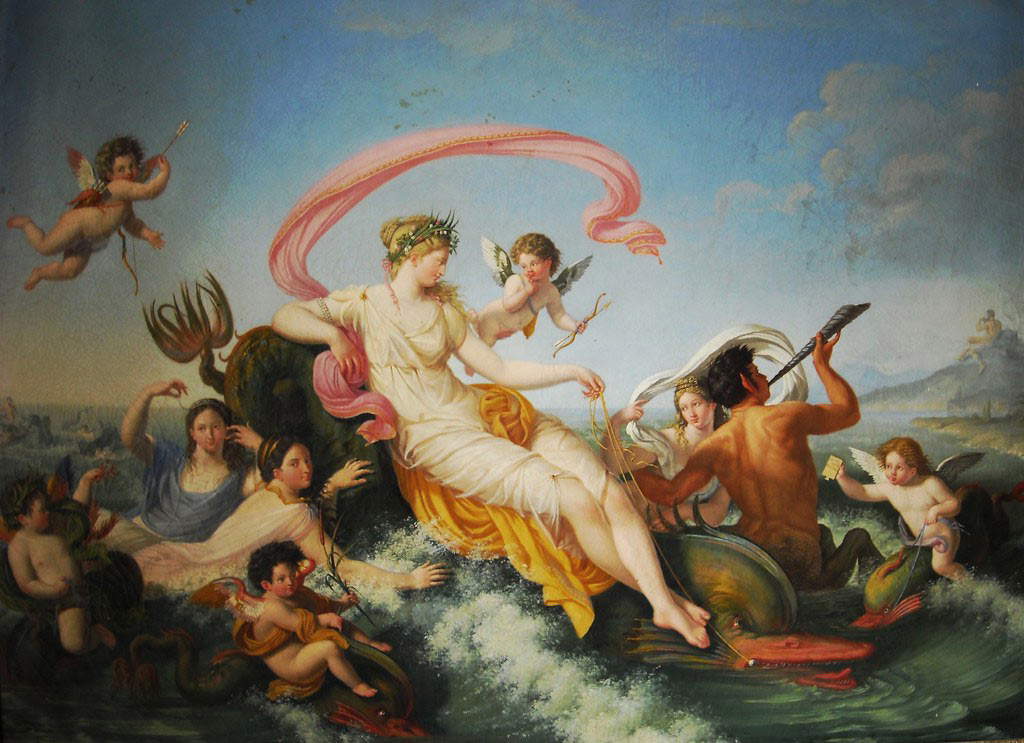
10. The tomb slab with the winged demon from Paestum.
It is not uncommon to come across animals fighting each other: this is demonstrated by this fight between a panther (or a lioness) and two griffins, one of which tries to seize the panther by attacking it from behind, in a fresco decorating a Lucanian tomb preserved at the National Archaeological Museum in Paestum. Toward the end of the fifth century B.C., the Lucanians, a population that inhabited the hinterland of today’s Basilicata, descended to the coast, occupying many settlements and towns in what is now Campania, including Poseidonia, the city of Magna Graecia foundation that would become the Roman Paestum. Normal, then, that the museum contains much evidence of this population, which like many other ancient civilizations used to paint the tombs of aristocrats. The use of depicting animals, real or fantastic, fighting each other, was of Eastern origin and spread to Italian territory in the 4th century B.C. In Paestum alone there are several slabs with similar motifs, and this is one of the best preserved.
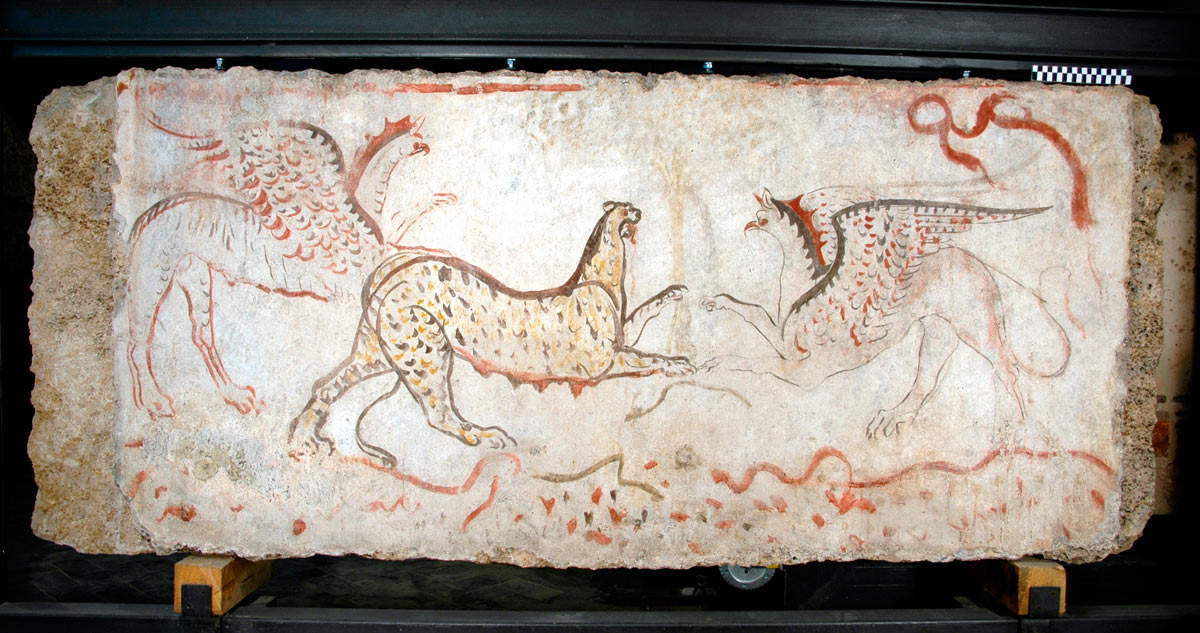
 |
| Animals and fantastic places in Italy's museums: Campania |
Warning: the translation into English of the original Italian article was created using automatic tools. We undertake to review all articles, but we do not guarantee the total absence of inaccuracies in the translation due to the program. You can find the original by clicking on the ITA button. If you find any mistake,please contact us.





























